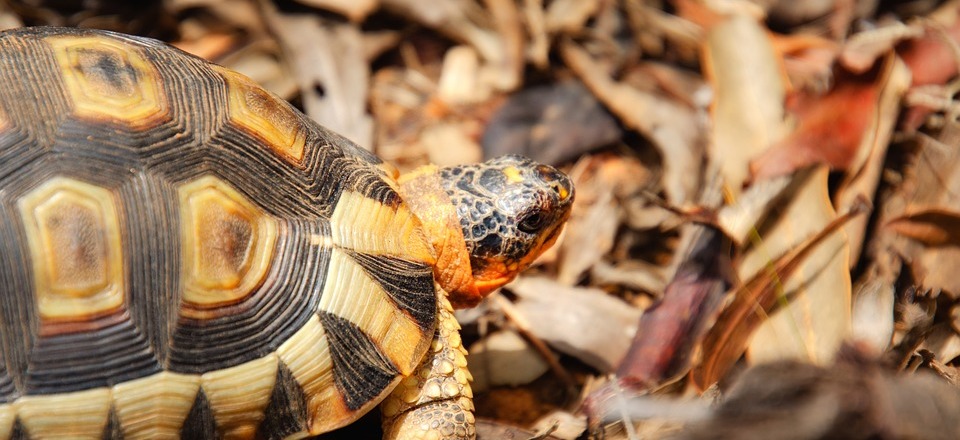Caution: Tortoise Crossing
- Species: Angulate Tortoise
- Habitat: Sandy coastal regions with bushveld and fynbos
If you're a resident or even an annual visitor to Gansbaai, you’ve probably noticed a tortoise or two crossing the road, especially during the spring and summer months. But why? Why are these little guys and girls so eager to crawl out of their burrows and start a traffic jam in the last place you’ll ever expect to find one?
Why are tortoises crossing the roads?
Due to the sheer volume of roads now running through pristine habitats, large habitats are now being split into smaller mini-habitats. This is called habitat fragmentation. It is now inevitable that tortoises will have to cross multiple roads throughout their lifetime. However, the hardy half-shelled reptiles are not deterred by the strange flat grey surface with its menacing machines. Fearlessly they cross it in search of better grazing land, freshwater, potential mates and sanctuary from predators.

What are the effects of a tortoise dying?
Unfortunately, smaller habitats and the nomadic nature of tortoises leaves them in great danger of being run over by cars and a lot more vulnerable to attack from predators such as birds of prey. These deaths take a toll on the number of tortoises in the ecosystem.
The most common species of tortoise found in Gansbaai is the angulate tortoise. A female angulate tortoise has a 30-year life expectancy and reaches sexual maturity when they are around ten years old. They can lay up to six or seven clutches of eggs per year and each clutch contains only one egg. Even under the best circumstances, it's not guaranteed that a single egg will hatch in a year. This means, when a female angulate tortoise loses her life the tortoise population potential growth suffers a blow.
Tortoise population issues aside, there is nothing worse than a little creature painfully losing its life.

How can you help?
So, how can you help? It depends on the situation, but a great place to start is by sticking to the speed limit and staying mindful on the roads. Not only does it keep the tortoises safe but also other drivers! If you’re driving on a remote gravel road the best thing to do when you see a tortoise on the road is to slowly and carefully drive around it. This way it doesn’t get too spooked and you won’t stand the risk of getting bitten, scratched or peed on if you try to pick it up.
If you come across one on a tarred road that is relatively busy, follow these instructions:
- Safely stop along the side of the road and be mindful of any approaching cars. Unfortunately, during the December holidays car accidents are more likely to happen. Busy roads aren’t just dangerous for tortoises!
- If you can, avoid picking the tortoise up. They generally don’t like that. Try and hurry it along.
- If you must handle the tortoise, lift it on both sides using both your hands. Keep the little creature horizontal and put it down on the side of the road in the direction it was travelling.
- Do not remove the tortoise and put it in your car so you can “look for a better spot”. It might just turn back and have to cross the same road, this time with an unhappy ending.
Did you know
In South Africa, there are roughly 20 different species of tortoises and terrapins. From dense coastal fynbos shrubs to dry regions in the Karoo and Namaqualand, they can be found in almost every habitat across the country.








.jpg?width=200&height=94)




































